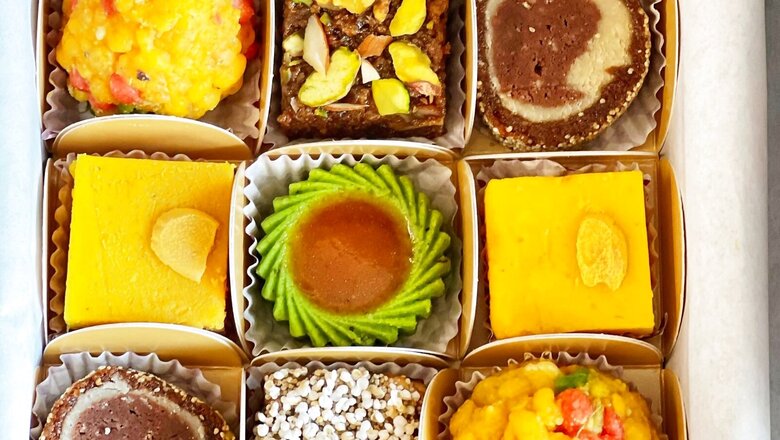
views
There was a time, in my thinner days, when I’d pop down to the junction of Kemps Corner and Gowalia Tank to Adarsh Mithai Bhandar to pick up 100 gm of Malai Barfi just as a treat. That grainy, soft, yellow coloured snug cake made out of pure milk, khoya, faux saffron colour and sugar was like a burst of luxury in your mouth. The shop was simple, lined with glass cases framed in wood, with bounteous mithais, barfis, pedhas, milk cakes displayed in small quantities frequently replenished from the inside kitchen when needed.
The hottest selling mithai was the “kaju katli” – a diamond-shaped cashew marzipan, coated with silver ‘warq’. Also, a brown honeycomb like milk cake also called ‘Alwar Ka Mawa’, an Indian version of a milk fudge prepared with full cream milk, sugar, and ghee. Rich, granular, creamy and mildly sweet and caramelized. Of course, there were ‘pedas’ of all colours, yellow, brown, white, even green and orange. Kalakand, a milk cake made with cottage cheese. Laddoos of all kind, especially the Motichoor ka laddoo, small soft besan ka boondi, bound together in goodness. Rubbery cornflower halwas in bright psychedelic colours. Sutarfeni, Mahim ka halwa, Mysore Pak, Jalebis, Gulab Jamuns and Sohan Papdi to name a few. Besan, ghee, sugar, dry fruits wheat, and cream all coming together to create a world of Indian sweets. Mithai making is a tradition that goes back centuries, so far back that some mithais that have been mentioned even in the Vedas. But the time has now come to disrupt that tradition, albeit respectfully and creatively.
And it is being galvanized by a young bunch of food entrepreneurs who I can only call visionaries. Modern-day Halwais, who have decided to keep the heart, soul and core of Indian mithais and spin them into avant-garde revolutionary interpretations. It’s what we need to be happening to the Indian cuisine as a whole, but I am overjoyed it is actually transpiring in the Indian confectionery world. I came across a few of these innovators and I was sweetly impressed.
Starting with the Bombay Sweet Shop. From the same guys that brought you the progressive Bombay Canteen and O Pedro, the Bombay Sweet Shop outlet is in a non-glamorous part of Mumbai but once inside is like Willy Wonka’s. Bright, colourful and full of activity, you can see their sweets being made right there and then. Their offering for this Diwali is eccentric yet full of nostalgia. Their two big ones are Pistachio Khubani Jim Jam. Harking to jam-filled Jim-Jam Biscuits this is a pistachio peda with apricot jam. Rangeela Laddu is a soft Motichoor with multicolored beads, mixed with Mawa. Of course, there is a lot more, including a fudge with Glucose biscuits, chikki made with savoury bhel, and a fine Kaju katli made with pure aromatic saffron.
The ITC Hotels have launched handcrafted traditional mithais with a modern twist as well. A never-ending list of handcrafted mithai, sweets and savoury Diwali goodies. I concentrated on the mithai and found it to be inventive yet familiar. Like Lavender Kaju Laddoos, with milk, nuts, soy and lavender flowers. Almond Pumpkin Seed, Apricot Clusters Enrobed in White Chocolate, and Cashew, Sunflower Seed Orange Peel Clusters Enrobed in Ruby Chocolate and Charoli, Melon Seed, Prune Clusters Enrobed in Milk Chocolate. These are just a few of a vast menu of modern Indian sweets.
Gur Chini is another luxury mithai maker that focusses on traditional taste especially for those who may be a little bit health conscious. They make an unbelievable range of ladoos and carefully crafted sweets that use natural sweeteners, like dates and organic ingredients like Natural Honey, Manuka, Buckwheat, Garchia, and Rosemary. To name a few mithais that impressed my sweet-tooth include Pink Motichoor Ladoo, Bournvita Burfi, Italian Brut Pistachio Ladoo, Pink Bubblegum Burfi, Gold Ladoo Kesariya Modak and Alwar Milk Cake with Nelon Gur.
From one of the minds behind restaurants like Social and Smokehouse Deli, Khoya is an Indian sweet brand that also fosters and safeguards ancient Indian recipes of mithai while adding a modern tweak. It all comes out well packaged and ingeniously delicious like Pink Motichoor Laddoo, Paan Peda, and Pista Longe, Sattu Peda, Khus Khus Peda, Rose Peda, Roasted Besan laddoo, Mewa Tokri.
And to prove that old has to make way for the new, Bikanervala, the giant mithai and namkeen makers famous for their Moong Dal Halwa, Bikaneri Bhujia and Kaju Katli since 1905, have launched a brand called Saugaat. Building on their century old ethos, tastes and traditions and a European twist they too have launched a range of innovative, new tastes and flavours. Like Lait Croquer– Indian, Turkish and French flavours of French wafer, Doda and Turkish Hazelnut. Orange Noir, as the name suggest, is an intense dark chocolate with orange. Cashew Bon Bon – Salted Caramel and Cashew Balls. Lemongrass Crème– Khoya flavoured with lemongrass. Crème de la Coco–passionfruit and ghee encased in crunchy coconut.
On this sweet note, may I wish all my readers, a happy, healthy and prosperous Diwali. As I always wish everybody, eat well, live well and – feed me as well.
Kunal Vijayakar is a food writer based in Mumbai. He tweets @kunalvijayakar and can be followed on Instagram @kunalvijayakar. His YouTube channel is called Khaane Mein Kya Hai. The views expressed in this article are those of the author and do not represent the stand of this publication.
Read all the Latest Lifestyle News here


















Comments
0 comment